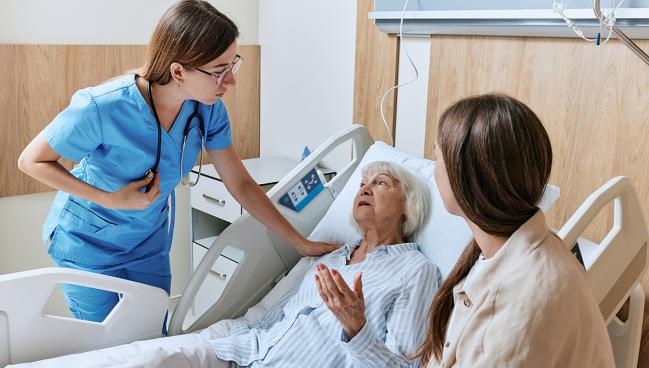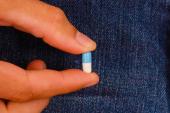Lower-Dose Edoxaban May Be an Option After Age 80: ENGAGE AF-TIMI 48 Analysis
One expert cautioned, however, that these results shouldn’t be applied to the DOACs commonly used in the US.

A lower-than-recommended dose of edoxaban (Savaysa; Daiichi Sankyo) lessens bleeding without compromising protection against ischemic events in elderly patients with atrial fibrillation (AF), a post hoc analysis of the ENGAGE AF-TIMI 48 trial suggests.
Among those without the standard dose-reduction criteria found on the drug’s label, patients who received 30 mg once daily had a lower risk of major bleeding, particularly GI hemorrhage, compared with those assigned to a 60-mg dose, with no differences in stroke/systemic embolism, ischemic stroke, or death, researchers led by André Zimerman, MD, PhD (Brigham and Women’s Hospital and Harvard Medical School, Boston, MA), report.
Moreover, among patients with or without an indication for dose reduction, edoxaban 30 mg lowered risks of major bleeding and intracranial hemorrhage compared with warfarin, without increasing ischemic events.
Importantly, Zimerman told TCMTD, those clinical findings were supported by pharmacodynamic data, which indicated that the lower edoxaban dose provided an anticoagulant effect in patients 80 and older similar to what was seen with the 60-mg dose in younger patients.
“This explains why we didn’t see an increase in ischemic events in these patients with the lower dose, but it prevented bleeding,” he said.
Instructions on edoxaban’s label say to give patients without criteria for dose reduction—ie, low body weight, impaired renal function, and use of a strong P-glycoprotein inhibitor—the full 60-mg dose, regardless of age. But these findings, published online this week in JAMA Cardiology, suggest that either the higher or the lower dose would be acceptable in older patients not meeting these criteria, allowing for an individualized decision, Zimerman said.
“Now I’m way more comfortable looking at a patient and I’ll think, ‘Well, maybe this person has a higher bleeding risk, is more frail, [so] maybe I’ll use a lower dose,’” he said. “And now I have evidence to support this showing that it can be appropriate in certain patients.”
Senior author Robert Giugliano, MD (Brigham and Women’s Hospital and Harvard Medical School), said it’s not clear how these findings will be translated into clinical practice, acknowledging that the analysis is limited by the post hoc design and the modest number of patients.
He added, “If you follow the prescribing label for edoxaban, you would give these older patients 60 mg, but what this paper shows is you’ll have less bleeding if you give 30 mg and you won’t concede many strokes, if any at all.”
For physicians who are already giving their older patients the lower dose due to fears of bleeding, “maybe this will give them some comfort to know that their instincts are supported by these data,” Giugliano said.
Post Hoc Findings
Prior research has shown that physicians commonly prescribe oral anticoagulants at lower-than-recommended doses, largely out of concerns about bleeding, despite the lack of support for such a strategy from randomized trials. And it’s been shown that such off-label dosing of direct oral anticoagulants (DOACs) is associated with worse adherence and poorer clinical outcomes.
The ENGAGE AF-TIMI 48 trial provided an opportunity to explore this question because it included three treatment arms:
- Edoxaban 60 mg once daily (or 30 mg for those meeting dose-reduction criteria)
- Edoxaban 30 mg once daily (or 15 mg for those meeting dose-reduction criteria)
- Warfarin
The main results showed that both doses of edoxaban were noninferior to warfarin in terms of stroke/systemic embolism and carried lower risks of bleeding and CV death. Subsequent analyses from the trial showed that the higher dose of edoxaban had more favorable effects in older versus younger patients; older adults had lower levels of endogenous factor Xa activity at baseline, suggesting a greater bleeding risk, and an enhanced response to oral factor Xa inhibition; and patients taking the lower versus higher dose were less likely to have a net clinical outcome event.
The current analysis focuses specifically on 2,966 patients age 80 and older (mean 83 years; 44% women), including 1,138 who did not meet any of the formal dose-reduction criteria.
In that smaller group, patients taking edoxaban 60 mg versus 30 mg had significantly greater risks of major bleeding (HR 1.57; 95% CI 1.04-2.38) and major GI hemorrhage (HR 2.24; 95% CI 1.29-3.90). There was no difference in the primary net clinical outcome (stroke, systemic embolic event, major bleeding, or all-cause death) or any of the efficacy endpoints.
The 30-mg dose also performed favorably when compared against warfarin in patients with or without dose-reduction criteria, with lower rates of the primary net clinical outcome (HR 0.78; 95% CI 0.68-0.91), major bleeding (HR 0.59; 95% CI 0.45-0.77), and death (HR 0.83; 95% CI 0.70-1.00) and a similar rate of stroke/systemic embolism.
Extrapolation to Other Drugs Unclear
Giugliano said these data are unique amongst the DOACs because of the link between clinical and pharmacodynamic data and the use of two different dosing regimens in the trial, noting that even though two doses of dabigatran were studied in RE-LY, the lower dose was not approved by the US Food and Drug Administration. Therefore, it’s unknown whether lower doses of the more commonly used DOACs—apixaban (Eliquis; Bristol-Myers Squibb) and rivaroxaban (Xarelto; Bayer/Janssen)—would provide results similar to what was seen in the current analysis of edoxaban.
This study “gives some additional information to the treating physician and to the patient to say, ‘Hey, if I run into an older patient with a high risk of bleeding, at least I know what I can expect if I give a lower dose with this drug,’” Giugliano said. “Whether that applies to other drugs, we don’t know.”
Commenting for TCTMD via email, Geoffrey Barnes, MD (University of Michigan, Ann Arbor), said “this study is intriguing because we’re always trying to reduce the risk of anticoagulant-related bleeding while still offering protection against stroke.” Bleeding increases the likelihood of discontinuing treatment, which in turn raises the risk for stroke, he noted. “So, avoiding bleeding is a laudable goal.”
Barnes added, however, that he’d be concerned about translating these findings with edoxaban to apixaban and rivaroxaban.
“Several other observational studies have shown that underdosing of those two anticoagulants is associated with inferior stroke prevention,” he said. “I would strongly urge clinicians to stick to the FDA package instructions for the dosing of apixaban and rivaroxaban. But, it’s also critical that patients have renal function testing to guide dosing and that any potential drug-drug interactions are reviewed and addressed.”
Todd Neale is the Associate News Editor for TCTMD and a Senior Medical Journalist. He got his start in journalism at …
Read Full BioSources
Zimerman A, Braunwald E, Steffel J, et al. Dose reduction of edoxaban in patients 80 years and older with atrial fibrillation: post hoc analysis of the ENGAGE AF-TIMI 48 randomized clinical trial. JAMA Cardiol. 2024;Epub ahead of print.
Disclosures
- Zimerman reports receiving a research scholarship from the Lemann Foundation and being a member of the TIMI Study Group, which has received institutional research grant support through Brigham and Women’s Hospital from Abbott, Abiomed, Amgen, Anthos Therapeutics, ARCA Biopharma, AstraZeneca, Boehringer Ingelheim, Daiichi Sankyo, Ionis Pharmaceuticals, Janssen Research and Development, MedImmune, Merck, Novartis, Pfizer, Regeneron Pharmaceuticals, Roche, Saghmos Therapeutics, Siemens Healthcare Diagnostics, Softcell Medical Limited, The Medicines Company, Verve Therapeutics, and Zora Biosciences.
- Giugliano reports receiving grants and consulting/lecture fees from Daiichi Sankyo; grants from Anthos; honoraria for continuing medical education programs from Medical Education Resources, Menarini, Pfizer, SAJA Pharmaceuticals, and Servier; data safety monitoring board fees from Artivion; and consulting fees from Samsung and Sanofi outside the submitted work, as well as being a member of the TIMI Study Group.
- Barnes reports consulting for Pfizer, Bristol Myers Squibb, Janssen, and Bayer.






Comments